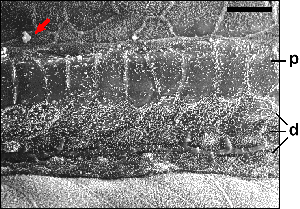| |
|
| Overview / Aminoglycosides / Noise Trauma / Excitotoxicity / Presbycusis / Tinnitus | |
| Pictures : M. Lenoir |
Aminoglycoside ototoxicity
Antibiotics from the aminoglycoside family have been known for years to cause severe damage to the organ of Corti, especially to hair cells in a dose-dependent manner. Firstly OHCs in the first row of the basal turn of the cochlea are affected, then progressively the other rows of OHCs and then the IHCs: the damage progresses towards the apex of the cochlea. The following set of scanning electron microscopy (SEM) pictures from the surface of the organ of Corti summarises an aminoglycoside antibiotic poisoning of the rat cochlea. |
 M. Lenoir |
SEM picture of the rat organ
of Corti. Normal organisation, with
1 row of IHCs (top) and 3 rows of OHCs (bottom). scale bar: 12 µm |
| Progressive damage of hair cells | |
 M. Lenoir |
The loss of hair cells begins
with OHCs from the first row in the basal turn. In humans, such a cochlea would show a mild hearing loss with speech discrimination problems. scale bar: 16 µm |
 M. Lenoir |
At higher dosage, the aminoglycoside
kills almost all OHCs, thus destroying their function (active
mechanism). In humans, such an organ of Corti would show a 60 dB threshold shift and no fine tuning. A hearing aid would easily restore the gain (loudness), but not the frequency selectivity (discrimination). scale bar: 16 µm |
 M. Lenoir |
At even higher doses, all
hair cells are missing (red arrow points to two giant stereocilia
on a damaged IHC). This
organ of Corti would no longer respond to any sound stimulation. |
